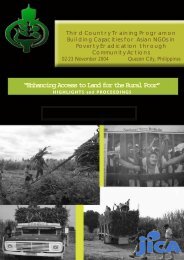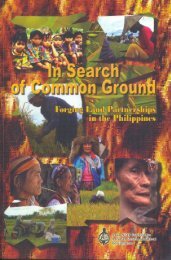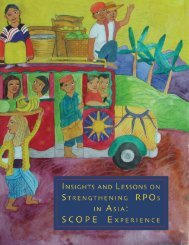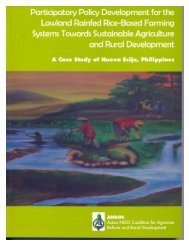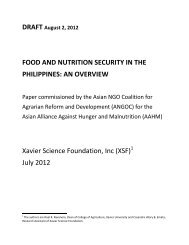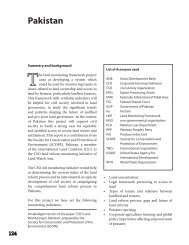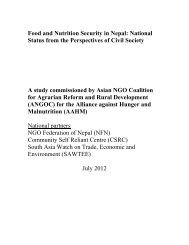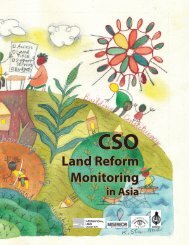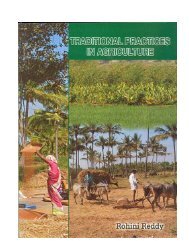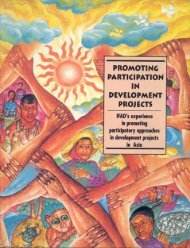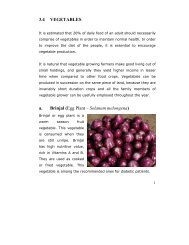Securing the Right to Land FULL - ANGOC
Securing the Right to Land FULL - ANGOC
Securing the Right to Land FULL - ANGOC
You also want an ePaper? Increase the reach of your titles
YUMPU automatically turns print PDFs into web optimized ePapers that Google loves.
SECURING THE RIGHT TO LAND134<br />
The Integrated Social Forestry (ISF) Program of 1982 recognized<br />
<strong>the</strong> people’s role in forest management. A Certificate of<br />
Stewardship (CS) or a Certificate of Community Forest Stewardship<br />
(CCFS) provided tenurial security for <strong>the</strong> first time for<br />
individuals and communities over 25 years. In 1989, <strong>the</strong><br />
Community Forestry Program (CFP) (Department of Environment<br />
and Natural Resources [DENR] Administrative Order No.<br />
123) through Community Forestry Management Agreements<br />
(CFMAs) awarded organized upland communities a period of<br />
25 years, renewable for ano<strong>the</strong>r 25 years, <strong>to</strong> utilize and sell<br />
products from within <strong>the</strong> residual forest, as well as establish<br />
plantations.<br />
There were also presidential issuances and proclamations declaring<br />
certain pieces of land as <strong>to</strong>urism zones or agricultural lands.<br />
Presidential Proclamation (PP) 2282 identified and declared certain<br />
areas from all <strong>the</strong> regions of <strong>the</strong> Philippines for agriculture<br />
and settlement. Most of <strong>the</strong> areas covered by PP 2282 were forest<br />
or ancestral lands. Some NGOs allege that PP 2282 is still being<br />
used <strong>to</strong>day <strong>to</strong> justify inclusion of upland areas and ancestral<br />
lands in o<strong>the</strong>r tenure reform programs or public land concessions.<br />
Constitutional Framework<br />
Philippine lands are ei<strong>the</strong>r inalienable (owned by <strong>the</strong> State) or<br />
alienable and disposable (may be privately owned). Various laws<br />
govern <strong>the</strong> nature and utilization of <strong>the</strong>se lands.<br />
The current legal framework for access <strong>to</strong> land is rooted in <strong>the</strong><br />
1987 Constitution. Article II, Declaration of Principles and<br />
State Policies, lays down <strong>the</strong> general principles of access <strong>to</strong><br />
land: (i) Protection of property [Section 5]; (ii) Promotion of<br />
social justice and human rights [Sections 10 and 11]; (iii) Promotion<br />
of rural development and agrarian reform [Section 21];<br />
(iv) Promotion of <strong>the</strong> rights of indigenous communities [Section<br />
22]; (v) Promotion of a self-reliant and independent national<br />
economy [Section 19]; and (vi) Protection of <strong>the</strong> right of<br />
<strong>the</strong> people <strong>to</strong> a balanced and healthful ecology [Section 12].<br />
O<strong>the</strong>r provisions in <strong>the</strong> Constitution fur<strong>the</strong>r underscore <strong>the</strong>se<br />
principles.<br />
Protection of property. Property can be taken away, but<br />
only with due process, and in certain cases, with just compensation.<br />
(Article III, Section 1 and 9)<br />
Promotion of social justice and human rights. The use of<br />
property must be regulated in <strong>the</strong> interest of social justice.<br />
(Article XIII, Section 1 and Article XII)<br />
Promotion of rural development and agrarian reform.<br />
The State must undertake an agrarian reform program<br />
founded on <strong>the</strong> right of farmers and regular farmworkers<br />
who are landless, <strong>to</strong> own directly or collectively <strong>the</strong> lands<br />
<strong>the</strong>y till or, in <strong>the</strong> case of o<strong>the</strong>r farmworkers, <strong>to</strong> receive a<br />
just share of its fruits. (Article XIII)<br />
Promotion of <strong>the</strong> rights of indigenous communities establishes<br />
<strong>the</strong> rights of indigenous communities <strong>to</strong> <strong>the</strong>ir ancestral<br />
lands. Section 5 of <strong>the</strong> Article on National Economy<br />
and Patrimony requires <strong>the</strong> State <strong>to</strong> protect <strong>the</strong> rights of indigenous<br />
cultural communities <strong>to</strong> <strong>the</strong>ir ancestral lands. (Article<br />
XIII, Section 6)<br />
Promotion of a self-reliant and independent national<br />
economy. The national economy must create a more equitable<br />
distribution of opportunities, income, and wealth and<br />
refers <strong>to</strong> agricultural development and agrarian reform as <strong>the</strong><br />
basis for industrialization and full employment. The State<br />
must also protect Filipino enterprises against unfair foreign<br />
competition and trade practices. (Article XII, Section 1)<br />
Protection of <strong>the</strong> right <strong>to</strong> a balanced and healthful<br />
ecology. Ecological considerations were made as bases for<br />
<strong>the</strong> State’s prioritization and setting of retention limits in undertaking<br />
agrarian reform. Congress must determine <strong>the</strong><br />
boundaries of forest lands and national parks. Such forest<br />
lands and national parks are <strong>to</strong> be conserved. Congress shall<br />
provide measures <strong>to</strong> prohibit logging in endangered forests<br />
and watershed areas. (Article XIII, Section 4). Requirements<br />
for conservation, ecology, and development, shall be considered<br />
by Congress in <strong>the</strong> determination of <strong>the</strong> size of lands of<br />
<strong>the</strong> public domain which may be acquired, developed, held,<br />
or leased. (Article XIII, Section 3)<br />
In sum, <strong>the</strong> 1987 Constitution shows a consistent policy that<br />
links land ownership and use <strong>to</strong> equitable distribution of<br />
wealth and <strong>to</strong> a balanced ecology. Corollary <strong>to</strong> this main policy<br />
are <strong>the</strong> restrictive policies on <strong>the</strong> alienation of lands and on<br />
<strong>the</strong> use of alienated and private lands, <strong>the</strong> policies on <strong>the</strong> conservation<br />
and protection of resources, and <strong>the</strong> recognition of<br />
<strong>the</strong> rights of farmers, indigenous communities and o<strong>the</strong>r<br />
marginalized groups. These policies should serve as <strong>the</strong> yardstick<br />
for legislation pertaining <strong>to</strong> access <strong>to</strong> land.<br />
Laws on Access <strong>to</strong> <strong>Land</strong><br />
At least five codes and 11 laws—most of <strong>the</strong>se based on <strong>the</strong><br />
1987 Philippine Constitution—affect <strong>the</strong> use and regulation of



